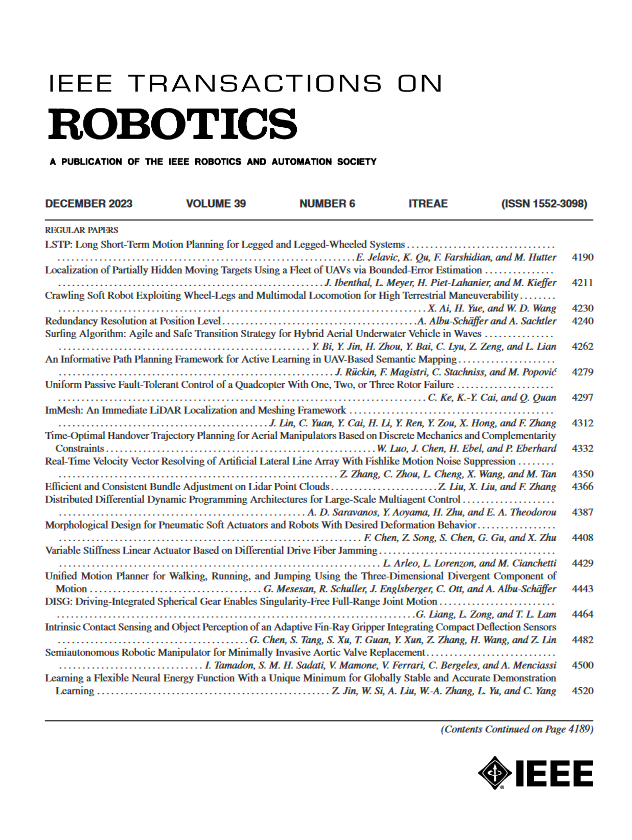Goal-Conditioned Model Simplification for 1-D and 2-D Deformable Object Manipulation
IF 10.5
1区 计算机科学
Q1 ROBOTICS
引用次数: 0
Abstract
Motion planning for deformable object manipulation has been a challenge for a long time in robotics due to its high computational cost. In this work, we propose to mitigate this cost by limiting the number of picking points on a deformable object within the action space and simplifying the dynamics model. We do this first by identifying a minimal geometric model that closely approximates the original model at the goal state; specifically, we implement this general approach for 1-D linear deformable objects (e.g., ropes) using a piece-wise line-fitted model, and for 2-D surface deformable objects (e.g., cloth) using a mesh-simplified model. Then a small number of key particles are extracted as the pickable points in the action space which are sufficient to represent and reach the given goal. In addition, a simplified dynamics model is constructed based on the simplified geometric model, containing much fewer particles and thus being much faster to simulate than the original dynamics model, albeit with some loss of precision. We further refine this model iteratively by adding more details from the actually achieved final state of the original model until a satisfactory trajectory is generated. Extensive simulation experiments are conducted on a set of representative tasks for ropes and cloth, which show a significant decrease in time cost while achieving similar or better trajectory costs. Finally, we establish a closed-loop system of perception, planning, and control with a real robot for cloth folding, which validates the effectiveness of our proposed method.一维和二维可变形对象操作的目标条件模型简化
可变形物体操作的运动规划由于其高昂的计算成本,长期以来一直是机器人技术中的一个难题。在这项工作中,我们建议通过限制动作空间内可变形物体上的拾取点数量和简化动力学模型来减轻这种成本。我们首先通过识别一个最小的几何模型来做到这一点,该模型与目标状态下的原始模型非常接近;具体来说,我们使用分段线拟合模型对一维线性可变形对象(例如,绳索)和使用网格简化模型对二维表面可变形对象(例如,布料)实现这种通用方法。然后提取少量关键粒子作为动作空间中足以表示并达到给定目标的可拾取点。此外,在简化几何模型的基础上构建了简化动力学模型,该模型包含的粒子数量少得多,因此比原始动力学模型的模拟速度快得多,但精度有所降低。我们通过从原始模型实际实现的最终状态中添加更多细节来进一步迭代地改进该模型,直到生成令人满意的轨迹。对一组具有代表性的绳索和布料任务进行了大量的仿真实验,结果表明,在获得相似或更好的轨迹成本的同时,时间成本显著降低。最后,我们用一个真实的折叠机器人建立了感知、规划和控制的闭环系统,验证了所提方法的有效性。
本文章由计算机程序翻译,如有差异,请以英文原文为准。
求助全文
约1分钟内获得全文
求助全文
来源期刊

IEEE Transactions on Robotics
工程技术-机器人学
CiteScore
14.90
自引率
5.10%
发文量
259
审稿时长
6.0 months
期刊介绍:
The IEEE Transactions on Robotics (T-RO) is dedicated to publishing fundamental papers covering all facets of robotics, drawing on interdisciplinary approaches from computer science, control systems, electrical engineering, mathematics, mechanical engineering, and beyond. From industrial applications to service and personal assistants, surgical operations to space, underwater, and remote exploration, robots and intelligent machines play pivotal roles across various domains, including entertainment, safety, search and rescue, military applications, agriculture, and intelligent vehicles.
Special emphasis is placed on intelligent machines and systems designed for unstructured environments, where a significant portion of the environment remains unknown and beyond direct sensing or control.
 求助内容:
求助内容: 应助结果提醒方式:
应助结果提醒方式:


